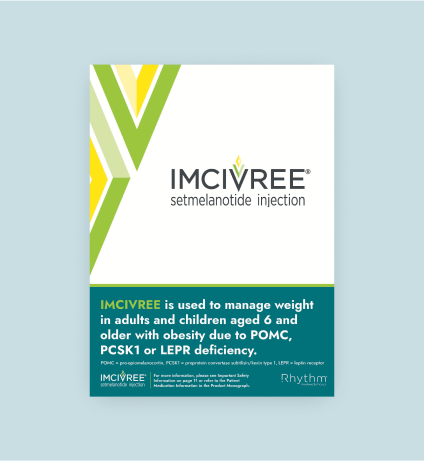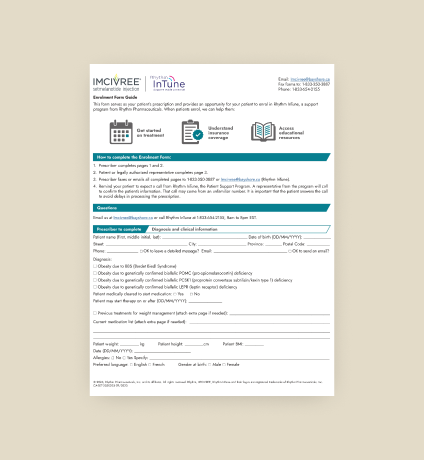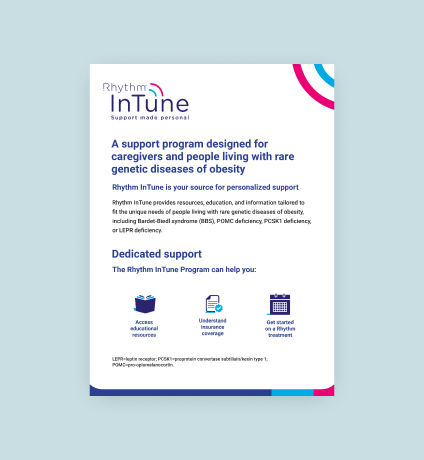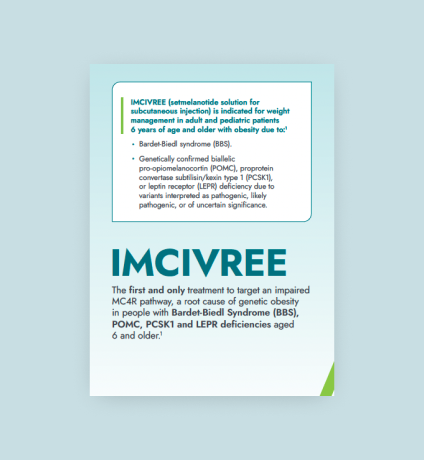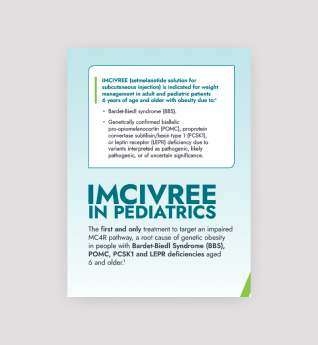Two identically designed phase 3 clinical trials measured weight reduction in patients aged 6 and older with POMC, PCSK1, or LEPR deficiencies1
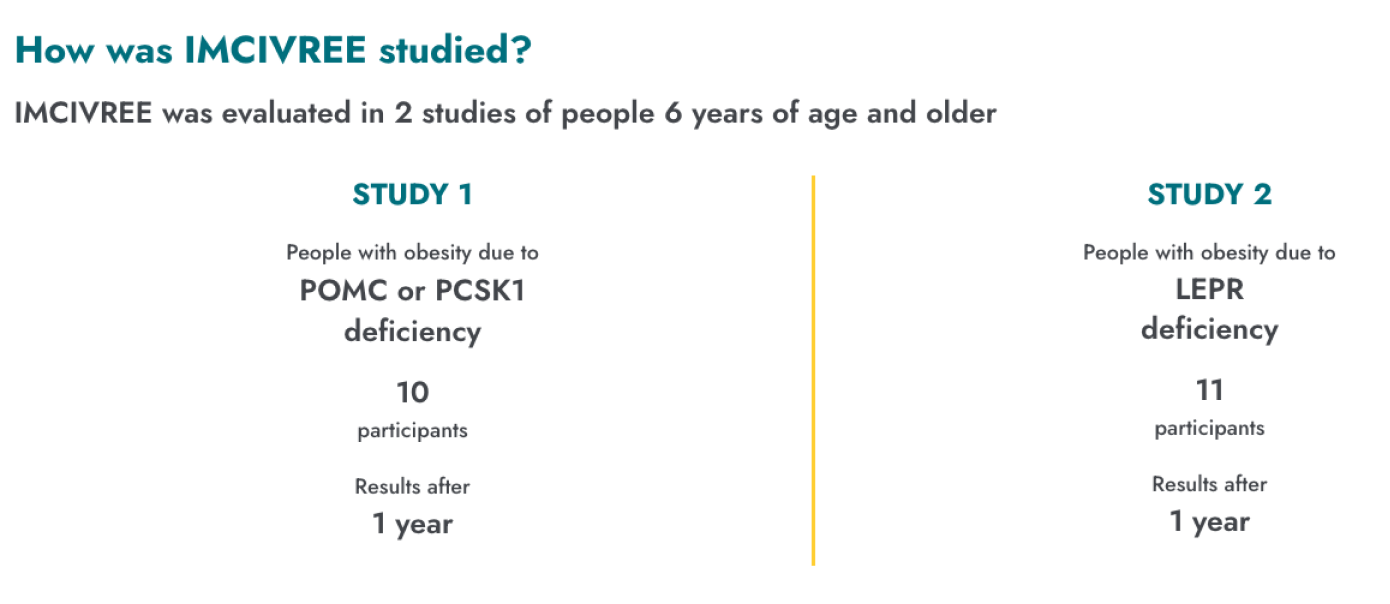
The efficacy and safety of IMCIVREE for weight management in patients aged ≥6 with obesity due to POMC, PCSK1, or LEPR deficiencies were assessed in two identically designed open-label studies, each with an 8-week, double-blind withdrawal period.

a The last 2 weeks of the open-label dose-titration phase in which the therapeutic dose for a participant was established were considered the first 2 weeks of the open-label treatment phase. Participants then received an additional 10 weeks of active treatment in the open-label treatment phase, for a total of 12 weeks of treatment at the therapeutic dose.
b Following the 12-week open-label treatment phase, participants who reached a weight loss threshold of at least 5 kg (or ≥5% weight loss for participants weighing <100 kg at baseline) entered the 8-week, double-blind, placebo-controlled withdrawal sequence. Participants received 4 weeks of setmelanotide and 4 weeks of placebo during this phase. The treatment sequence was not randomized.
Efficacy in the POMC, PCSK1, LEPR trial
In patients aged ≥6 with POMC, PCSK1, or LEPR deficiencies a significant proportion of patients achieved ≥10% weight loss at week 52.1
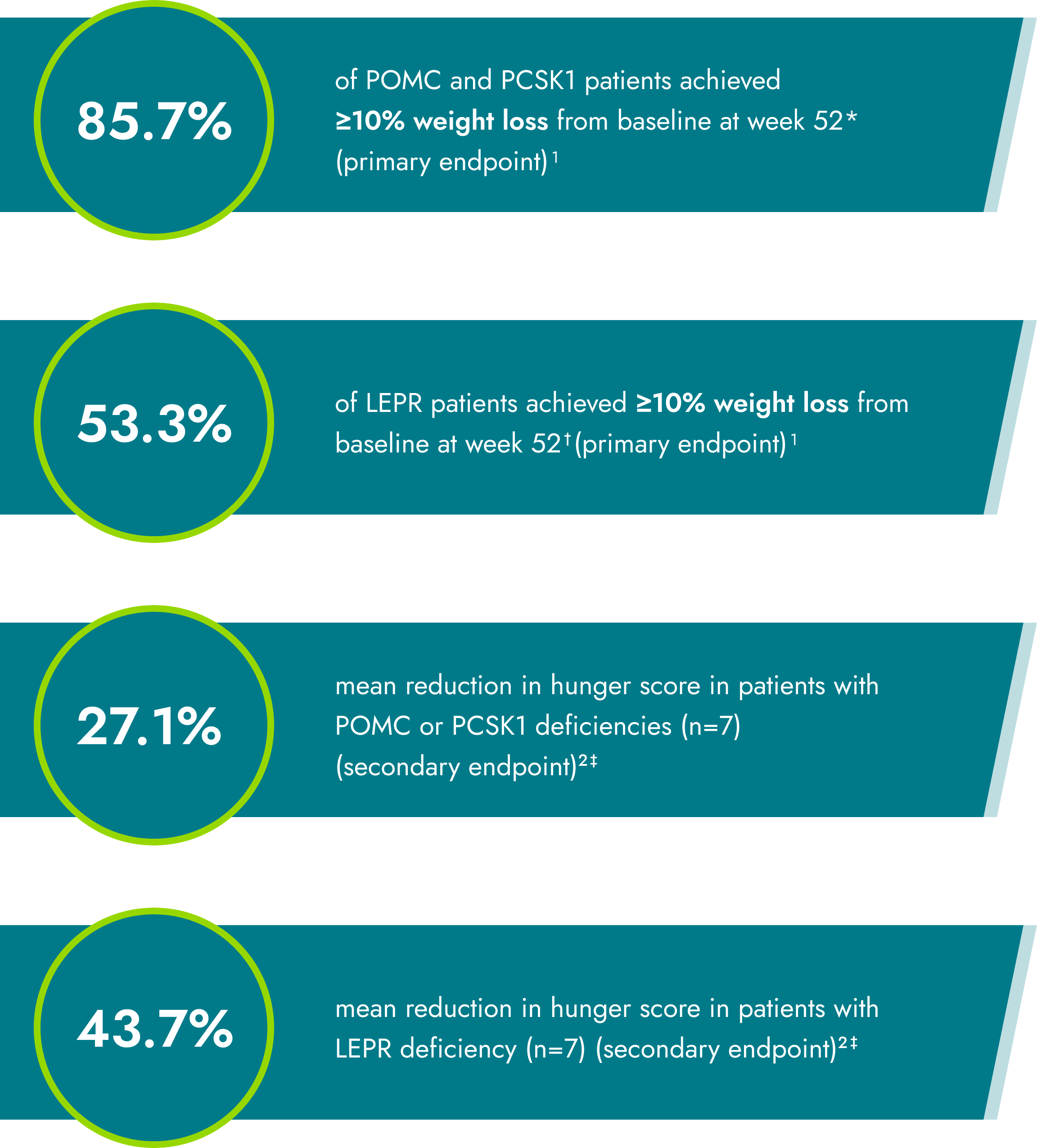
* 90% CI: 61.46-97.40
† 90% CI: 30.00-75.63
‡ Patients ≥12 years of age who were able to self-report their hunger recorded their daily maximal hunger in a daily diary and averaged to calculate weekly scores for analysis. The most hunger score was captured using the question “In the last 24 hours, how hungry did you feel when you were the most hungry?” Hunger was scored on an 11-point scale from 0 (“not hungry at all”) to 10 (“hungriest possible”).2
Safety in the POMC, PCSK1, LEPR trial
IMCIVREE has a well established safety and tolerability profile.
Adverse reactions occurring in ≥5% of IMCIVREE-treated patients in the POMC, PCSK1, and LEPR deficiency clinical trials.1
| IMCIVREE (n=30) | |
|---|---|
| Injection site reaction* | 90% |
| Skin hyperpigmentation† | 57% |
| Nausea | 53% |
| Headache | 50% |
| Diarrhea | 40% |
| Spontaneous penile erection‡ | 40% |
| Abdominal pain§ | 33% |
| Vomiting | 33% |
| Back pain | 30% |
| Melanocytic naevus | 30% |
| Fatigue | 27% |
| Depression‖ | 23% |
| Asthenia | 23% |
| Dizziness | 17% |
| Vertigo | 13% |
| Dry mouth | 13% |
| Chills | 10% |
| Anxiety | 10% |
| Alopecia | 10% |
| Erythema | 7% |
| Hyperhidrosis | 7% |
| Rash papular | 7% |
* Includes injection site erythema, pruritus, edema, pain, induration, bruising, hypersensitivity, hematoma, nodule, and discolouration.
† Includes skin hyperpigmentation, melanocytic naevus, and pigmentation disorders.
‡ n = 15 male patients.
§ Includes abdominal pain and upper abdominal pain.
‖ Includes depression and depressed mood.
Click here to read the Warnings and Precautions associated with IMCIVREE.
Once-daily, subcutaneous injection that can be administered at home1
Titrate IMCIVREE to the recommended dose.
In patients aged 6 to 17 years:1
- The starting dose of setmelanotide is 0.5 mg (0.05 mL) injected subcutaneously once daily for 2 weeks.
- Monitor patients for GI adverse reactions to adjust dosage.
- The dose may be increased by 0.5 mg daily every 2 weeks if tolerated to a maximum dose of 2.0 mg daily.
- If the starting dose is not tolerated, IMCIVREE should be discontinued.
In patients aged ≥18 years:1
- The starting dose of setmelanotide is 1 mg (0.1 mL) injected subcutaneously (SC) once daily (QD) for 2 weeks.
- Monitor patients for gastrointestinal (GI) adverse reactions to adjust dosage.
- The dose may be increased by 0.5 mg daily every 2 weeks if tolerated to a maximum dose of 3.0 mg daily.
- If the starting dose is not tolerated, IMCIVREE should be discontinued.
IMCIVREE should be administered once daily, at the beginning of the day, without regard to meals – there is no food requirement for administration.1
No dose adjustments are needed for patients with mild to moderate renal impairment.1
IMCIVREE is not recommended for use in pediatric patients <12 years of age with severe renal impairment or for use in patients with end stage renal disease.1
For adults and pediatric patients 12 years of age and older with severe renal impairment (eGFR 15 to 29 mL/min/1.73 m2):1
- The starting dose of setmelanotide is 0.5 mg (0.05 mL) injected subcutaneously QD for 2 weeks.
- Monitor patients for GI adverse reactions.
- The dose may be increased by 0.5 mg daily every 2 weeks if tolerated to a maximum of 1.5 mg daily.
- If the starting dose is not tolerated, IMCIVREE should be discontinued.
Dosing considerations:1
- IMCIVREE should be prescribed and supervised by a physician with expertise in obesity with underlying genetic aetiology.
- IMCIVREE should be administered once daily, at the beginning of the day, without regard to meals.
- Select patients for treatment with IMCIVREE who have genetically determined deficiency of POMC, PCSK1, or LEPR or clinical diagnosis of BBS.
- Assess response to IMCIVREE therapy regularly.
- In patients with POMC, PCSK1, or LEPR deficiency, evaluate weight loss after 12 to 16 weeks of treatment. If a patient has not lost at least 5% of baseline body weight or 5% of baseline BMI for patients with continued growth potential, discontinue IMCIVREE as it is unlikely that the patient will achieve and sustain clinically meaningful weight loss with continued treatment.
- In pediatric patients, evaluate the impact of weight loss on growth and maturation.
Getting your patient started on IMCIVREE
- The Rhythm InTune Enrolment Form is available here or from Rhythm Territory Managers.
- Follow the instructions to complete the form.
- Submit all pages of the completed form via fax to 1-833-350-3887 or email [email protected].
Financial support may be available to eligible patients for whom IMCIVREE treatment is prescribed. For questions on IMCIVREE or how to start a patient, call Rhythm InTune at 1-833-654-2155 Monday-Friday, 8 am to 8 pm ET.
Patient support and resources
In this section, you can find information on educational resources produced by Rhythm. We will continue to update this page with additional resources about rare melanocortin-4 receptor (MC4R) pathway diseases.
for Patients
Enrolment Form
Flashcard
Brochure
References:
1. IMCIVREE (setmelanotide solution for subcutaneous injection) Product Monograph. Rhythm Pharmaceuticals Inc. May 4, 2023. 2. Clément K et al. Lancet Diabetes Endocrinol. [Supplementary Appendix] 2020;8(12):960-970.

